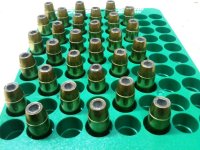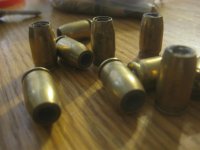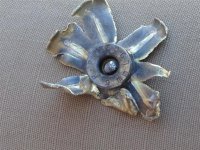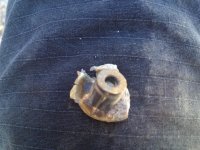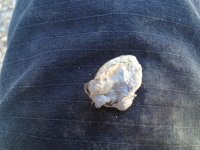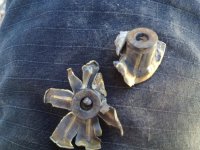You are using an out of date browser. It may not display this or other websites correctly.
You should upgrade or use an alternative browser.
You should upgrade or use an alternative browser.
build a hollow point
- Thread starter jinx
- Start date
The cartridge is ignited by the primer being struck not by holding it while drilling the bullet. Many tools form the point of a 22lr by striking it with a hammer or pushing on an arbor press and are quite safe.
I have the forester HP tool and use it occasionally but prefer the groups I get with cast HP ammunition.
I have the forester HP tool and use it occasionally but prefer the groups I get with cast HP ammunition.
David LaPell
Member
- Joined
- Mar 9, 2008
- Messages
- 5,541
- Reaction score
- 6,781
I tried drilling out a .22 LR to see what would happen, apparently I went to deep because I remember it as soon as that bullet left the barrel it seemed to turn into a grey mist and vaporized. If you want to have some hollowpoints and can cast your own bullet, head over to CastBoolits, there is a fella there named Buckshot who hollow points moulds. He took a single cavity #358156 and turned it into a hollow point mould and it works great. You can HP those wadcutters and you will have similar to the old Hydrashok Skorpions. Although I do recall Skeeter Skelton finding that those wadcutters actually did perform quite well for a defensive round.
BJoe
Member
For hunting or target sure. DO NOT...NOT...NOT...however carry one in a defensive situation.
10 Spot Terminator
Member
- Joined
- Feb 9, 2013
- Messages
- 39
- Reaction score
- 5
Using the Forster case trimmer to hollow point bullets works in such a way that it takes away the risk of accidental detonation entirely. The loaded round is supported by a ringed collet that when tightend grips the cartridge only by the outside of the rim on the case. There is nothing but open air around the base of the case leaving the primer totally out of harms way. As for drilling into the bullet itself you are drilling maybe 1/2 way through the bullet at best and never get close to the powder. Team that with the fact all you are drilling are non ferrous metals you would die of old age before you could get a spark that would ignite the powder. Rimfires on the other hand would need to be gripped buy the case in someway tight enough to keep it from spinning along with the bit and hopefully without any form of support under the base within at least an inch and a half or more. If for some reason that Billion to One odds of that rimfire going off did occur and as long as the case were not supported at the base the bullet would exit with maybe the force of a cb short or less while the brass exited the other way. Remember you need to have the round locked in a chamber for it to launch the bullet to its designed potential. This said I wouldnt waste my time on .22 bullets at this point in time but if times got hard I might reconsider.
10 Spot
10 Spot
Titegroups
Member
Unchambered rounds rounds arent deadly if set off, they go off like a firecracker and the powder being between a heavy bullet and lighter weight case send the case flying several feet while the bullet remain close by. As a kid I would lay 30-06 rounds primer facing toward me and hit them with a pellet gun from a distance and dicovered physics still won out as usual.
I well remember the Goerg hollow pointers, they came in 38 spcl. , 357mag. , 41 mag. 44 spcl. , 44 mag. 45 colt and 22 LR.
Forster made a pistol hollow pointer , for use on thier hand cranked case trimmer for all of the above ( except 22 LR ) and the 45 ACP.
They also made a accessory tool for thier power case trimmer for " any caliber rifle or pistol cartridge" complete with guide bushing and drill. All of these tools were to be used on " gasp " loaded ammunition. How did we survive...
Actually it is not as dangerous as you think. Back then , except for Super-Vel , there were no hollow points loaded by the factories. I bought hollow pointed moulds from Lyman so I could have those magic bullets. Super-Vel were so expensive they sold them in boxes of 50 instead of 100 like the other makers.
Gary
I still have my Forster trimmer and hollow point attachment. I used it a lot. No danger what so ever.
pps
Member
Yes, I have a Cramer style penta pin mold in 45 Colt, and another mold like this (standard hollow point) for .380 auto:


Expansion is good.



Expansion is good.

Shooter6br
Member
One has to consider the bullet alloy (hardness) and velocity the bullet will travel.I use 25-1 alloy for 38 Special +P.....
Cast bullet reference on lead alloy's, min / max pressure, lube, shrinkage,
Cast bullet reference on lead alloy's, min / max pressure, lube, shrinkage,
Last edited:
LoboGunLeather
US Veteran
Played with the Georg hollow pointing tools a bit back in the 1970's. Since then I have relied on cast bullets and several of my molds are for hollow points. One is the Lee 358-150SWC-HP, with wheel weights throws a 142-grain HP bullet that I have used successfully on Colorado mule deer in the 200 lb. range.
I can't agree with the comment that factory semi-wadcutter hollow points are not effective self-defense rounds. All of the factory stuff will have swaged bullets made of a very soft lead alloy (to permit swaging to shape). With the large flat frontal area these can be very effective.
Over-penetration can be an issue with any self-defense ammo, solid or hollow-point. I have seen hollow points pass completely through a human body (including one that broke a shoulder) and continue on. The hollow point by itself is no guarantee against over-penetration, only a possible means for preventing it.
Frankly, in an immediate self-defense situation (essentially kill or be killed) you have to do what you have to do. You may not want your bullet to continue on through the target and strike something else, but that is always a possibility. You may hold your fire and allow someone to kill you if you wish, but I don't know if I would.
I can't agree with the comment that factory semi-wadcutter hollow points are not effective self-defense rounds. All of the factory stuff will have swaged bullets made of a very soft lead alloy (to permit swaging to shape). With the large flat frontal area these can be very effective.
Over-penetration can be an issue with any self-defense ammo, solid or hollow-point. I have seen hollow points pass completely through a human body (including one that broke a shoulder) and continue on. The hollow point by itself is no guarantee against over-penetration, only a possible means for preventing it.
Frankly, in an immediate self-defense situation (essentially kill or be killed) you have to do what you have to do. You may not want your bullet to continue on through the target and strike something else, but that is always a possibility. You may hold your fire and allow someone to kill you if you wish, but I don't know if I would.
Because it is a highly over penetrative and is a poor SD load.
NOT!
Where's the unlike button?
Over-penetration can be an issue with any self-defense ammo
Ballistic personal defense weapons work by penetration. "Over-penetration" is a bizarre concept.
44wheelman
Member
- Joined
- Feb 2, 2006
- Messages
- 1,699
- Reaction score
- 987
Over penetration is when the bullet passes through the intended target, and hits unintended targets, like kids or neighbors.
mistermills357
US Veteran
Shoot Them, It Ain't Worth All Of The Trouble.
Shoot them just like they are, then load yer own. You can buy a 200 count bag of 125 grain hollow point for $25.
.357 Bullets
Shoot them just like they are, then load yer own. You can buy a 200 count bag of 125 grain hollow point for $25.
.357 Bullets
Last edited:
Over penetration is when the bullet passes through the intended target, and hits unintended targets, like kids or neighbors.
The problem with handguns is adequate penetration. Heck, most people are going to miss the bad guy, anyway.
Big Cholla
Member
I lived and fished Alaska in the early '70s. It was common among us Fly Fishermen to carry a .44 Mag in a shoulder holster for Griz protection. A very popular theory was that the .44 Mag worked best for that purpose if the bullet was drilled with a 1/8" dia. hole (dead center of course) and then a steel 3/16" x 1/4" set screw placed in said hole. I remember making up about 50 each of such a load. I used my gunsmithing skills to machine an aluminum block with five 'chambers' for .44 Mag in the block all in near perfect alignment. I then set up the mill as a precision drill press and drilled the holes in loaded cartridges to that exact 1/4" depth. The aluminum block had to be slit with a narrow cutting bandsaw to allow the block to be mechanically squeezed together to hold the cartridges firm to prevent spinning while being drilled. I checked the accuracy and it was still as good as the original cartridges were. I never had to shoot a Griz with that load (thank goodness) and I never in the near five years I was in Alaska ever heard of anyone that did. I ran across that machined aluminum block in my scrap metal bin just a few weeks ago.
M
MnrePeat
Guest
Has anyone ever made their own hollow point bullet? I ask because there is no ammo available in my area{just like everywhere else}, but I did find a hidden box of 158 grain lead semi wad cutters. Nice flat point on them and was thinking I could drill my own hollow point. Is this possible or better yet, worth it?
I would appreciate any thoughts. Thanks
I did it with hard lead rn lots of times the edges get sharp as hell
And looks like a flying cereal bowl shot very accurate as
Long as it's centered good
M E Morrison
Member
Because it is a highly over penetrative and is a poor SD load.
Not true in my experience. What can you point out that gives proof to this claim? Opinions are just that, unless backed up by documented events.
Similar threads
- Replies
- 11
- Views
- 409
- Replies
- 36
- Views
- 3K

